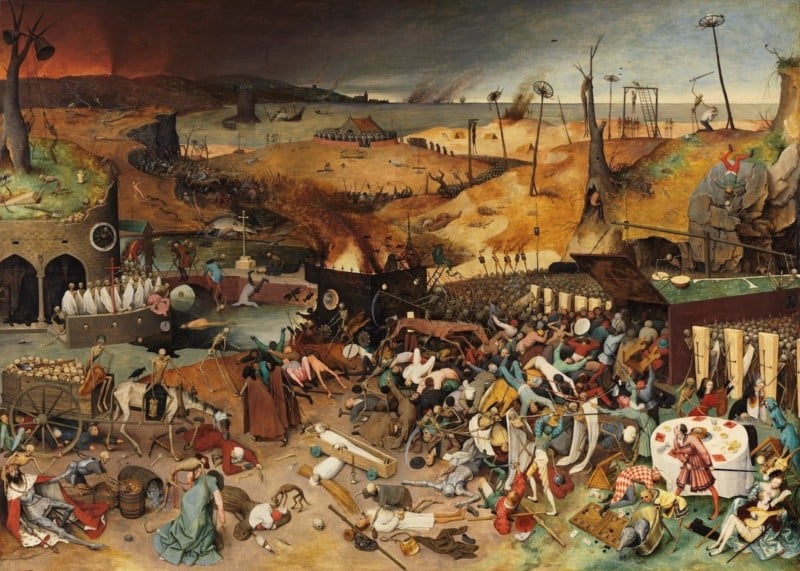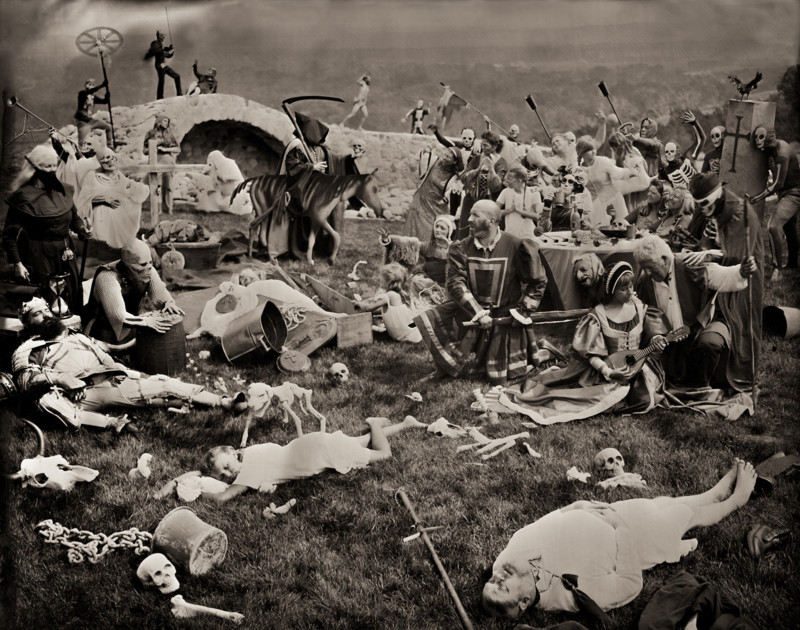![]()
For the past five years, I have organized an annual photographic Tableaux Vivant based on classic paintings. I have included anywhere from 15, or in the instance of my 2021 construction, No Vaccine for Death, 90 collaborators.
Ideas come from everywhere. Occasionally we self-generate. More often they are thrust upon us. Photographic history is certainly replete with expansive portraits. Utilizing a digital camera, group portraits can be captured quickly, in rapid succession, and at a moment’s notice.
My portraiture, however, vastly differs from the work of contemporary photographers as I turn the clock back with the use of Frederick Scott Archer’s 1851 medium of wet plate collodion, and it is thought that less than 1,000 photographers practice this archaic form of analog photography in present day. I am very proud to be one of them.
In the wet plate process, liquid collodion is poured over a piece of polished black glass, sensitized in a bath of silver nitrate, exposed in the camera, and then developed immediately (under safe light conditions), usually within minutes, as to not allow the collodion to dry on the plate and the image lost.
For location work, I have built a portable darkroom that is easily transported. All development must be done instantly and on-site. For the techies, I use an Italian Alessandro Gibellini 8×10-inch bellows studio camera mounted with a Carl Zeiss Tessar 300mm f/4.5 lens with a manual lens cap as my shutter. No Vaccine for Death was shot outside under the open haze of a Bismarck, North Dakota sky (artfully and unfortunately provided by the California wildfires) with a one-second exposure at f/11.
No Vaccine for Death is the fifth largest production that my friend, collaborator, project director, and St. Mary’s College (of Bismarck) film professor Marek Dojs and I have worked on together. Each time we start a new project, it seems we get more ambitious and attempt to push the envelope of what is, or seems to be, possible. Two years ago, our project was going to be something completely different. We had a painting of saints descending from, and people ascending to, heaven. The image personified the conflict between the ideas of good and evil.
When COVID hit, we knew we had to confront the pandemic.
With the onset of the pandemic, life, as we well know it, changed in a heartbeat.
“In regards to the theme — one thing that I’ve been thinking a lot about is how afraid of death our society has become. The idea that we will live forever, and that pain and suffering should be avoided at all costs, has created a lot of problems in our time. The pandemic brings the possibility of death closer to us, but death is the real pandemic — and there will be no vaccine for that — we will all die. No Vaccine for Death might be an interesting title,” Marked said at the time.
At that point, No Vaccine for Death was born. In a meeting several days later, Marek and I discussed The Triumph of Death, Pieter Bruegel’s 1562 masterpiece which hangs in Madrid’s Museo del Prado. Inspired by the unstoppable onslaught of Europe’s Black Plague which killed over 25 million people (nearly a third of Europe at the time, and which lingered on for hundreds of years longer), our wet plate shoot could not have come at a more poignant time in modern history. The world had just started to recover from the COVID-19 pandemic.

Marek and I thought that if we could immortalize this scene through our own visual vocabulary, we could possibly put COVID behind us. Marek, cognizant of our inevitable death, felt that if people focused so much time and energy on things that are not important, we would lose track of our time here on Earth. He wanted to stress the fact that there is no vaccine for mortality. In so doing, we attempted to pay homage to Bruegel’s original image.
With the concept firmly in hand, our efforts turned towards the logistics of production. Needing an open and accessible location, my first call was to Monsignor Shea, the President of the University of Mary here in my hometown of Bismarck, North Dakota. On the college grounds is the sacred Marian Grotto which formed the basis for the scene. The stone arch of the grotto was a close match to the stonework in our inspirational painting from 459 years ago.
I then enlisted the aid of Michael Stevenson and Michele Renner Oster, directors of the local (Shakespearean) theatre companies for the creation of costumes. Forty backup and support personnel, including make-up artists, hairstylists, carpenters, dressers, and armorers were pressed into action. Dozens of skeleton costumes were purchased, altered, and fitted for the various volunteers. As a matter of fact, once the call for actors went out on social media, over 100 respondents ranging from local university students to photographers from San Diego, St. Louis, and Cleveland, Ohio, asked to be part of, then joined, the collaboration.
Finally, the morning of July 21 arrived. I had barely slept. At 6:00 am, I was on-site with a flatbed pick-up truck arranging camera angles and laying out the relative positions of each of the participants. By 8:00 am, the temperature had hit 80 degrees (on its way to 100 a couple of hours later).
![]()
![]()
![]()
![]()
The intrepid actors were in full-length Renaissance costumes and ready to be placed. I estimated it would take at least eight collodion plates to get the perfect shot. Each plate would take a minimum of 30 minutes to expose, develop, and evaluate, let alone allowing the actors time to stretch, move around, grab a bottle of water, and then reset.
![]()
As it is often said, a wet plate is not taken, it is given to you. I was prepared to work until I had a satisfactory image. Fortunately, my crew was likewise committed.
![]()
![]()
I mounted the truck, double-checked the exposure, and left to coat the first plate with collodion. Marek, bull horn in hand, directed the actors to their positions.
The first plate was over-exposed.
![]()
![]()
![]()
Nailing down a precise exposure on a first attempt using natural light is always a challenge. Reset, I took another plate which I judged as adequate. It’s now an hour later and the sun has really begun to take its toll. A third plate was exposed, we were beginning to see our vision for the shot unfold. As everyone gathered around to see the results once it was washed, a cheer went up with the general agreement we were close.
![]()
![]()
We took a short break and went for our fourth and final plate of the day. All the elements we were trying to incorporate and capture became visible. We had our one plate, the plate that would represent our 18 months of planning. The final plate is being donated to the State Historical Society of North Dakota with a list of all of the collaborators that were involved.
![]()
![]()
We had something to show for our moment in the sun. A pure silver-on-glass image when properly curated will exist for hundreds if not thousands of years after we are all gone. One second of our lives immortalized as a reminder to others of our time together.
![]()
Pizza served. Champagne uncorked. Camaraderie exchanged. Congratulations were shared by all.
We were asked by the local media if this is the largest “live” wet plate collaboration of all time? To that, we had no answer or concern. We just wanted to come together for no other reason than to create as a group. The history and significance of our time together will be left up to others to determine.

I want to thank each and every person that contributed to this fabulous adventure. I am so blessed to be on this creative path with all of you.
Editor’s note: A full list of all those involved in this production as well as a great deal more behind-the-scenes images can be viewed on Shane Balkowitsch’s website.
About the author: Shane Balkowitsch is a self-taught photographer from Bismarck, North Dakota that specializes in wet plate collodion photography. He believes this process is magical because the end result is tangible and precious. His extensive work in the medium can be seen on his website. The documentary Balkowitsch details his growth from a quirky businessman in his 40s who was looking for a creative outlet and stumbled upon an archaic form of photography that changed his life’s path. Eight years later, his Native American wet plate photos are being archived around the globe, and his recent portrait session with Greta Thunberg at Standing Rock Indian Reservation has been seen by millions and is in the vaults of the Library of Congress.
No comments:
Post a Comment